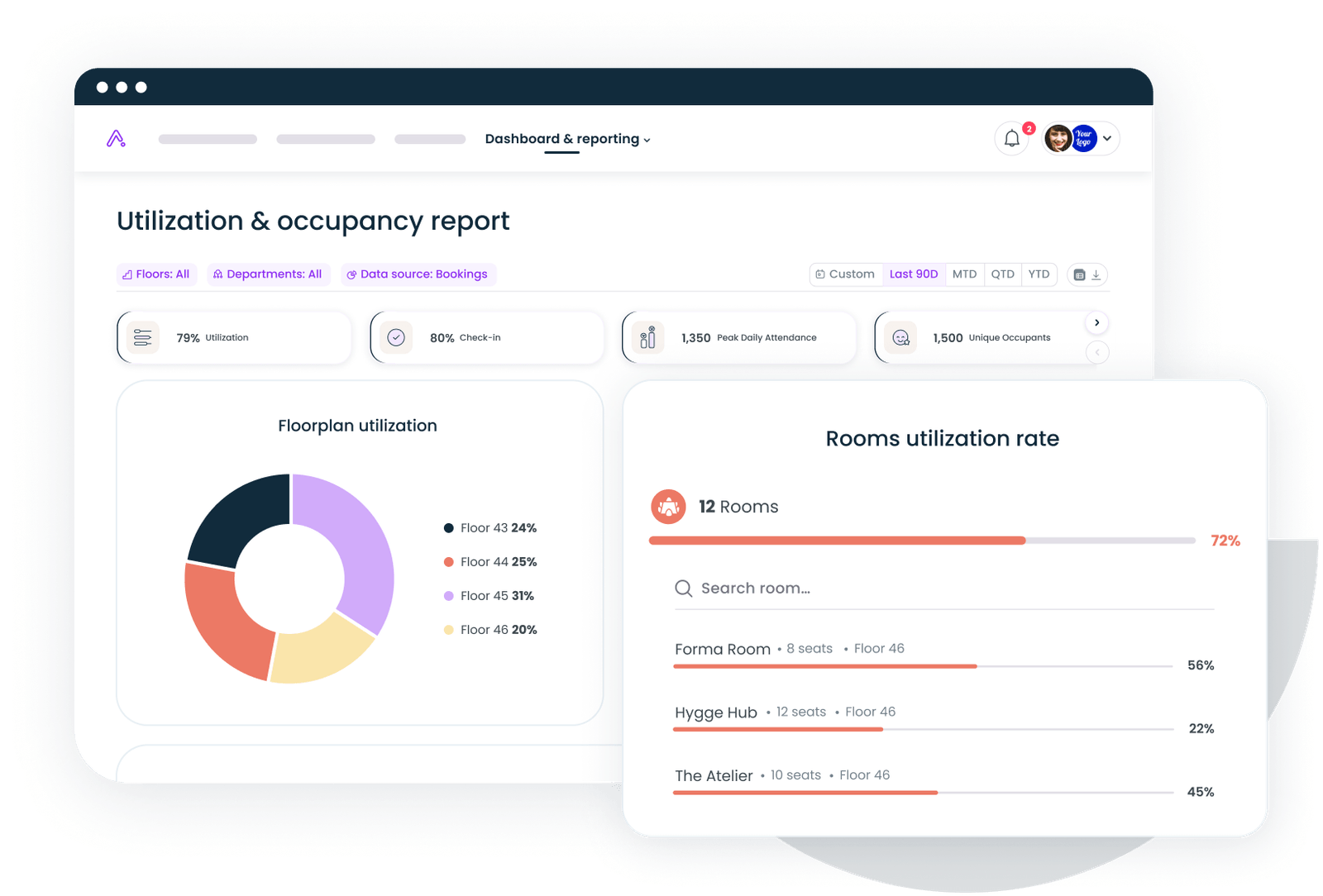Conference rooms are shared resources that require mutual respect and clear guidelines. Yet many organizations struggle with basic meeting room etiquette, leading to double bookings, late arrivals, and frustrated employees.
According to Bain & Company research, companies spend 15% of their time in meetings, with upper management dedicating up to 50% of their time to collaborative sessions. When conference room etiquette breaks down, all that time becomes far less productive.
This guide covers the essential conference room etiquette tips, why they matter for workplace culture, and how companies can effectively communicate and manage these expectations.
Why conference room etiquette matters
Conference room etiquette isn't just about manners. It directly impacts your bottom line, employee experience, and organizational effectiveness in measurable ways.
Productivity and time management
Unproductive meetings cost businesses upwards of $375 billion annually. When meetings start late because the previous group hasn't cleared out, or when teams waste time looking for available space because of double bookings, the cost compounds quickly.
Employees spend an average of 11.3 hours per week in meetings. Even minor improvements to meeting efficiency through better etiquette multiply across your organization. Starting and finishing meetings on time, keeping spaces clean, and following proper booking procedures ensure a productive environment for everyone.
Resource optimization
Conference rooms are a significant real estate investment. Poor conference room etiquette compounds waste by causing ghost meetings, double bookings, and scheduling conflicts that leave valuable resources sitting idle.
Organizations that implement proper meeting room guidelines alongside a room booking system report better space utilization and more accurate decision-making data. When teams follow proper booking procedures, workplace managers gain reliable insights into which spaces are genuinely needed.

The physical setup of your conference rooms influences how well teams follow etiquette guidelines. Learn how to create meeting spaces optimized for productivity and collaboration.
Read the guide
The 10 essential rules of conference room etiquette
1. Book conference rooms in advance
Planning ahead is the cornerstone of proper meeting room etiquette. Use your meeting room booking system to reserve spaces in advance. This ensures you get the conference room you want while allowing coworkers to plan their schedules accordingly.
Last-minute bookings create unnecessary stress and scheduling conflicts. Most organizations find that booking rooms at least 24 hours in advance works well for routine meetings, while critical presentations should be reserved even earlier.
2. Cancel bookings when meetings change
When your plans change, don't wait until the last minute to cancel your reservation; do it immediately. This frees up shared spaces for other employees who might need them and ensures a harmonious work environment.
35% of meeting invites are sent with less than 24 hours' notice, and 90% of one-off meetings are organized within 10 days. When you hold onto a booking you no longer need, you block other groups during that critical planning window.
3. Start and finish meetings on time
Punctuality is among the most critical aspects of meeting room etiquette. Meetings start at their scheduled time out of respect for all participants, and finishing meetings on schedule ensures the next group can begin promptly.
When meetings run late, they create a domino effect. To maintain proper etiquette, arrive a few minutes early to set up. Have a clear agenda and end 5-10 minutes before your booking concludes, to give the next occupants time to settle in.
4. Keep conference rooms clean and organized
Leave every conference room cleaner than you found it. This ensures shared meeting spaces remain professional and welcoming for all users.
Before departing, clear all personal belongings from the space. Dispose of coffee cups, food wrappers, or trash in appropriate bins. Return furniture to its original configuration if you rearranged it. Erase whiteboards completely.
5. Respect booking procedures
Respecting other people's schedules and reservations is a key component of conference room etiquette. Never walk into a booked conference room assuming you can take it over, even if it appears empty.
Double bookings create unnecessary conflict, waste valuable time, and undermine trust. Modern meeting room booking systems prevent double bookings through real-time availability displays, but the technology only works when everyone uses it consistently and there's a clear understanding of procedures.
6. Minimize digital distractions
To ensure meetings run smoothly, focus on mental presence rather than just physical attendance. When you're in a meeting, be fully present, engaged with the discussion, and try to contribute effectively.
73% of professionals multitask during meetings, with 52% doing so often or always. This divided attention reduces meeting effectiveness and shows disrespect to whoever is leading the discussion.
Put your phone on silent and resist checking emails during meetings. For hybrid meetings, this becomes even more critical. Remote participants can feel disconnected when in-person attendees are clearly distracted. Being fully present ensures better collaboration and more productive outcomes for the whole team.
Conference room etiquette works best when paired with space management tools. Discover how to track utilization, improve booking efficiency, and make data-driven real estate decisions.
Explore Gable Room Scheduling Software
7. Consider the needs of remote participants
As hybrid work becomes the standard, proper meeting etiquette includes ensuring remote employees feel equally included. This requires intentional effort from in-office participants.
Position yourself where cameras can capture everyone clearly. Speak toward microphones rather than away from them. Don't rely on pointing at shared screens that remote participants might not see; verbally describe what you're referencing.
Encourage remote participants to share their perspectives and periodically pause to gather their input. Test your conference room technology before important hybrid meetings to avoid technical difficulties.
8. Limit food and drink
An unwritten rule is that while a cup of coffee is generally acceptable, eating a full meal during a meeting violates good meeting room etiquette. Food becomes a distraction and risks creating a mess.
Strong food smells can be particularly problematic in enclosed meeting rooms. They linger long after you leave and may cause discomfort for colleagues. Save substantial meals for before or after your meeting, and clean up any spills immediately.
9. Follow dress and behavior standards
Know your audience and dress appropriately for the meetings on your calendar. A meeting with external clients calls for a more formal attire, while internal sessions may allow business casual.
Behavior matters equally. Maintain professional language, avoid side conversations, and don't dominate the discussion. Your conduct can create a lasting positive impression that affects business relationships and career advancement.
10. Report issues and maintain equipment properly
When you encounter problems in a conference room, reporting them promptly is part of good etiquette. Broken equipment or technical issues won't fix themselves.
Return room settings, such as lighting or temperature controls, to their defaults before leaving. These considerations show respect for shared resources and create a productive work environment for everyone.
How to communicate etiquette expectations effectively
Even comprehensive etiquette guidelines only work when employees know about them. Organizations need multi-channel communication strategies to embed these expectations into workplace culture.
Create clear rules and policies
Document your conference room rules in writing. A clear policy removes ambiguity about expectations and provides employees with a concrete reference.
Your policy should cover key rules while remaining concise. Include specifics about booking procedures, time limits, cleanup expectations, and equipment usage. Make this document easily accessible in your employee handbook and during onboarding.
Making feedback easy and actionable
Create clear channels for employees to report etiquette issues or suggest improvements. When you receive feedback about conference room problems, act on it quickly.
Regular pulse surveys asking about meeting room experience provide valuable data. Track metrics such as booking satisfaction and cleanliness ratings over time to gauge whether your etiquette initiatives are improving the workplace experience.
How to use technology to support conference room etiquette
While technology can't replace good manners, the right tools make it significantly easier for employees to follow proper etiquette. Modern workplace management platforms address many common challenges.
Streamlining the booking process
Friction in the booking process leads people to skip it entirely, creating scheduling conflicts. A user-friendly room booking system makes proper booking procedures the path of least resistance.
Look for solutions that integrate with tools your team already uses. Real-time availability displays prevent double bookings by showing which meeting rooms are open and when. Mobile access matters increasingly as hybrid work grows.
Automated reminders and accountability
Technology can automate reminder functions that previously required constant management attention. Automated emails before scheduled meetings prompt attendees to cancel if plans have changed, reducing ghost meetings that waste resources.
Check-in systems that require confirmation of attendance help identify patterns of booking abuse. Usage analytics show which spaces are in high demand, enabling data-driven decisions about space management.
Integrating with broader workplace management
Conference room booking works best as part of a holistic workplace management approach. When desk booking, visitor management, and room reservations are integrated into a single platform, the experience becomes seamless. This makes it easier to plan productive in-office days and ensures the right resources are available when teams come together.
Discover how modern space scheduling software eliminates common frustrations around booking, cancellations, and resource visibility for hybrid teams.
Get a demo





.svg)





.svg)
















.svg)













